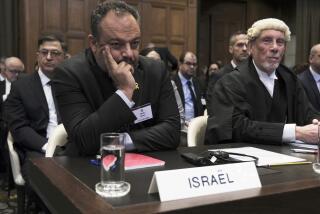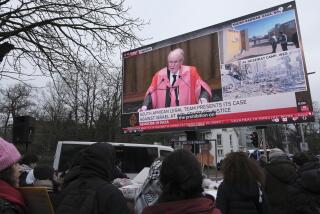Panel Sees Images of Horror as Genocide Trial Starts
- Share via
THE HAGUE — Calling it a “triumph of evil,” U.N. prosecutors showed footage of meadows filled with corpses and bones decaying in mass graves as the trial opened Monday of the highest-ranking Serb to go before a tribunal on genocide charges.
Bosnian Serb Maj. Gen. Radislav Krstic is charged in Europe’s bloodiest massacre since World War II: the July 1995 slaughter of at least 7,000 Muslim men and boys at Srebrenica, a U.N.-declared “safe area.”
“The manner in which these people perished and the scale of this atrocity is truly incomprehensible by every standard of humanity,” said prosecutor Mark Harmon, a former unit chief in the U.S. Justice Department. “This is a case about the triumph of evil.”
The massacre at Srebrenica, Bosnia-Herzegovina, has come to symbolize the terrifying tragedy of the 1992-95 Bosnian war’s “ethnic cleansing” campaigns.
Prosecution witness Jean Rene Ruez set the scene for the U.N. war crimes tribunal. The French forensics expert narrated a film of refugees being crowded into a U.N. compound in Srebrenica and receiving assurances of safety from the Serbs, “to make sure that they would go like ‘organized cattle’ ” to their deaths, he said.
Harmon showed the three-judge panel harrowing photographs of the mass graves where the refugees ended up. A skull was still wrapped in a blindfold in one exhumed grave. In another, the victim’s wrists were tied with wire.
Investigators led by Ruez have exhumed 1,800 corpses over five years and believe that 2,500 more are still buried.
Krstic, who commanded the Bosnian Serb army’s Drina Corps during the war, is charged with every crime under the judges’ jurisdiction: genocide, war crimes, crimes against humanity and grave breaches of the Geneva Conventions.
He has pleaded innocent. Conviction would bring a maximum life prison term. The U.N. court has no death penalty.
Judges Almiro Simoes Rodriques of Portugal, Fuad Riad of Egypt and Patricia Wald of Washington, D.C., listened as Harmon described the prosecution’s case.
“Over a period of about five days, thousands of Bosnian Muslim civilians and Bosnian Muslim soldiers who had laid down their arms were systematically murdered by members of the Bosnian Serb army,” Harmon said.
Those who tried to hide, he said, “were hunted down with dogs and slaughtered.”
The Serbian offensive against Srebrenica was designed to wipe out the Muslim population of an enclave deep inside an area of Bosnia that the Serbian leadership saw as strategically vital.
Serbian forces ordered a Dutch peacekeeping battalion to stand aside and embarked on a campaign of extermination and deportation. Muslim men were bused to execution sites, homes were burned, and the main mosque was razed.
More to Read
Sign up for Essential California
The most important California stories and recommendations in your inbox every morning.
You may occasionally receive promotional content from the Los Angeles Times.













